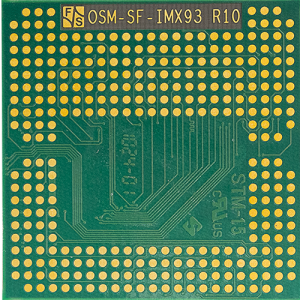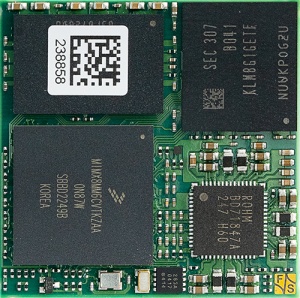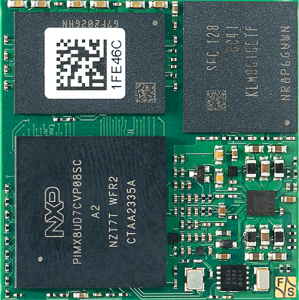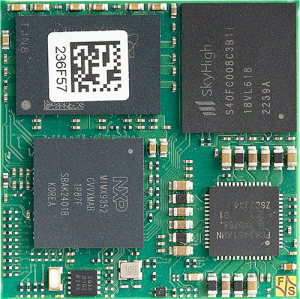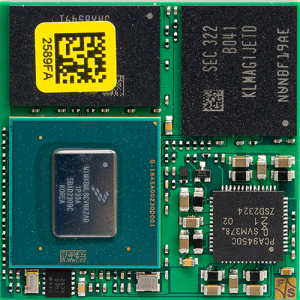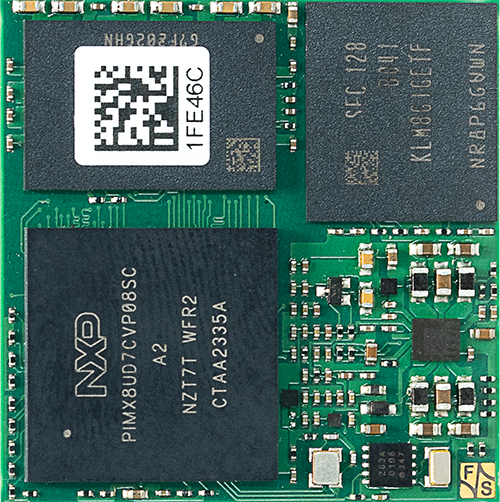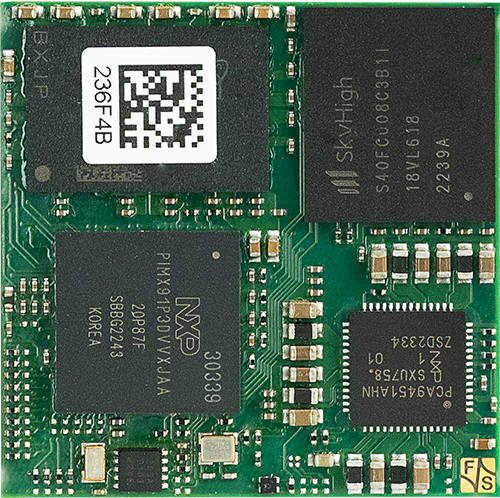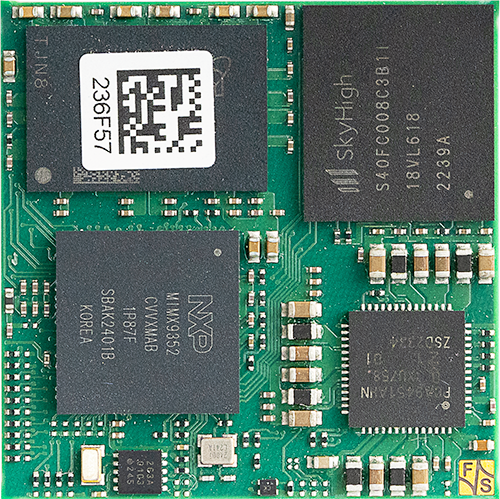OSM™
The Open Standard Module (OSM) is an industrial standard (SGeT) for solder-on modules developed by F&S and others. While the OSM standard accommodates various sizes (Size 0, S, M, L), F&S focuses specifically on OSM Size-S.
Using OSM Size-S offers numerous advantages. Here are some key reasons to consider using OSM Size-S:
- Compact and Powerful Design:
OSM Size-S provides an optimal balance between size and computing power. With a footprint of just 30 x 30 mm, it offers enough space for high-performance 64-bit processors such as the i.MX8M Mini with 4x Cortex A53 (1.8GHz) or the i.MX93 with 2x Cortex-A55 (1.7GHz), including DDR-RAM and eMMC Flash. - Faster Time-to-Market and Cost Efficiency:
The standardized formfactor and uniform interfaces significantly reduce development time.
The modules can be assembled with pick-and-place machines within the SMD production line, eliminating the need for manual assembly and screwing. - Future-Proofing and Investment Protection:
The modules can be easily swapped to adapt to changing requirements, ensuring long-term investment protection. - Reduced Development Risks:
OSM Size-S is based on an established industrial standard supported by many manufacturers, minimizing the risk of incompatibilities and technical issues. Extensive documentation (Design-In, processing) helps to avoid errors in the carrier board development. The software is optimally tuned to the modules and undergoes extensive testing (e.g., temperature, compliance, cooling) to ensure stability. - Robustness and Reliability:
The use of LGA pads ensures a stable and reliable connection, which is especially beneficial in demanding harsh environments.
All modules are available in industrial temperature ranges as well.
| FS 8MM OSM-SF | FS 8ULP OSM-SF | FS 8MP OSM-SF | FS 91 OSM-SF | FS 93 OSM-SF | |
| State | Production | Samples | Samples | Q2/2025 | Production |
| CPU | - | - | - | - | - |
| CPU | NXP i.MX 8M Mini | NXP i.MX 8ULP | NXP i.MX 8M Plus | NXP i.MX 91 | NXP i.MX 93 |
| Core | ARM Cortex-A53 Cortex-M4 |
ARM Cortex-A35 Cortex-M33 Hifi 4 DSP |
ARM Cortex-A53 Cortex-M7 HiFi-4 DSP, NPU, ISP |
ARM Cortex-A55 | ARM Cortex-A55 Cortex-M33 NPU |
| No of Cores | 4x A53 + M4 | 2x A35 + 1x M33 + DSP | 4x A53 + M7 | 1x A55 | 2x A55 + M33 + NPU |
| Frequency | max. 1.8GHz + 400MHz | 800MHz + 216MHz + 600MHz | max. 1.8GHz + 800MHz | 1.4GHz | 1.7GHz + 250MHz |
| L2-Cache | 512kB | 512kB | 512kB | 256kB L2 | 2x64kB L2 + 256kB L3 |
| NPU | - | - | 2.3 TOPS | - | 0.5 TOPS |
| GPU | 2D, 3D | 2D, 3D: ES™ 3.1, CL™, VG™ 1.1 | 2D, 3D: ES 3.1/3.0, CL™ 1.2, VG™ 1.1 | - | PXP |
| VPU | Decode: 1080p60 HEVC/H.265, H.264, VP9, VP8 Encode: 1080p60 H.264, VP8 |
- | Decode: 1080p60 H.265, H.264, VP9, VP8 Encode: 1080p60 H.265, H.264 |
- | - |
| Security | - | - | - | - | - |
| Secure Element | - | - | - | Edgelock Secure Enclave | Edgelock Secure Enclave |
| Operating System | - | - | - | - | - |
| Linux | Yocto (uboot installed) |
Yocto (uboot installed) |
Yocto (uboot installed) |
Yocto (uboot installed) |
Yocto (uboot installed) |
| Real Time | FreeRTOS | FreeRTOS | FreeRTOS | - | FreeRTOS |
| Memory | - | - | - | - | - |
| Flash | 64 kbit EEPROM | 64 kbit EEPROM | 64 kbit EEPROM | 64 kbit EEPROM | 64 kbit EEPROM |
| eMMC | max. 64GB | max. 64GB | max. 64GB | max. 64GB | max. 64GB |
| RAM | max. 8GB LPDDR4 x32 |
max. 2GB LPDDR4 x32 |
max. 8GB LPDDR4 x32 |
max. 2GB LPDDR4 x16 |
max. 2GB LPDDR4 x16 |
| Interfaces | - | - | - | - | - |
| SD-Card | 2x SDIO | 1x SDIO | 2x SDIO | 1x SDIO | 1x SDIO |
| Ethernet | 1x RGMII | 1x RMII | 2x RGMII | 2x RGMII | 2x RGMII |
| USB Host | 1x OTG 2.0 | 1x OTG 2.0 | 1x OTG 3.0 | 1x OTG 2.0 | 1x OTG 2.0 |
| USB Device | 1x OTG 2.0 | 1x OTG 2.0 | 1x OTG 2.0 | 1x OTG 2.0 | 1x OTG 2.0 |
| CAN | - | 1x | 2x CAN-FD | 2x CAN-FD | 2x CAN-FD |
| UART | 4x | 5x | 4x | 5x | 5x |
| I2C | 3x | 3x | 3x | 3x | 3x |
| SPI | 2x | 2x | 2x | 2x | 2x |
| Audio | 1x I2S | 2x I2S | 2x I2S | 1x I2S | 1x I2S |
| Digital I/O | 24 GPIO_A/_B/_C |
20 GPIO_A/_B/_C[4..7] |
24 GPIO_A/_B/_C |
12 GPIO_A+_C[4..7] |
12 GPIO_A+_C[4..7] |
| ADC | - | - | - | 2x | 2x |
| Touch Panel | via I2C or USB | via I2C or USB | via I2C or USB | - | via I2C or USB |
| Camera | MIPI-CSI (4 lanes) |
MIPI-CSI (2 lanes) |
MIPI CSI (4 lanes) |
- | MIPI-CSI (2 lanes) |
| PCIe | 1x PCIe 3.0 (1 lane) |
- | 1x PCIe 3.0 (1 lane) |
- | - |
| RTC | PCF85263ATL | PCF85263ATL | PCF85263ATL | PCF85263ATL | PCF85263ATL |
| More | 3x PWM, BL-PWM | 5x PWM, BL-PWM, 2x DAC | 3x PWM, BL-PWM | 2x PWM, BL-PWM | 2x PWM, BL-PWM |
| Display | - | - | - | - | - |
| RGB | - | 18 (24) bit 1V8 or 3V3 |
- | - | - |
| LVDS | - | - | 1x 4 lanes | - | 1x 4 Lanes |
| CRT/DVI | - | - | DVI | - | - |
| MIPI-DSI | 1x 4 Lanes | 1x 4 Lanes | 1x 4 lanes | - | 1x 4 Lanes |
| Common | - | - | - | - | - |
| V_IN | 5V DC/±5% | 5V DC/±5% | 5V DC/±5% | 5V DC/±5% | 5V DC/±5% |
| T_AMB | 0°C - +70°C -25°C - +85°C -40°C - +85°C |
0°C - +70°C -25°C - +85°C -40°C - +85°C |
0°C - +70°C -25°C - +85°C -40°C - +85°C |
0°C - +70°C -25°C - +85°C -40°C - +85°C |
0°C - +70°C -25°C - +85°C -40°C - +85°C |
| Size | 30x30mm | 30x30mm | 30x30mm | 30x30mm | 30x30mm |
| Availability | 2034+ | 2038+ | 2036+ | 2040+ | 2038+ |
| FS 8MM OSM-SF | FS 8ULP OSM-SF | FS 8MP OSM-SF | FS 91 OSM-SF | FS 93 OSM-SF |
FS OSM-SF
- OSM Implementation Guide (1.9 MB, pdf) - 13/08/2025
- OSM Cooling Solution (592 KB, pdf) - 16/04/2024
- OSM Carrier Board Design (1.2 KB, txt) - 28/08/2025
- OSM Carrier Board Design Library (16 MB, zip) - 03/09/2025
- Hardware Documentation ADP-OSM-BB (366 KB, pdf) - 29/07/2025
- SGeT OSM standard - (external link)
Usage
By downloading you accept our general terms and conditions.
Usage
By downloading you accept our general terms and conditions.
Usage
By downloading you accept our general terms and conditions.
Usage
By downloading you accept our general terms and conditions.
Usage
By downloading you accept our general terms and conditions.
FS OSM-SF - Quick Facts
- FS 8MM OSM-SF (697 KB, pdf) - 29/07/2025
- FS 8MP OSM-SF (715 KB, pdf) - 29/07/2025
- FS 8ULP OSM-SF (764 KB, pdf) - 29/07/2025
- FS 91 OSM-SF (776 KB, pdf) - 11/04/2025
- FS 93 OSM-SF (786 KB, pdf) - 29/07/2025
Usage
By downloading you accept our general terms and conditions.
Usage
By downloading you accept our general terms and conditions.
Usage
By downloading you accept our general terms and conditions.
Usage
By downloading you accept our general terms and conditions.
Usage
By downloading you accept our general terms and conditions.
Extensive product documentation is provided alongside each product.
 |
Starter Kit FS 8MM OSM-SF Linux Evaluation kit for FS 8MM OSM-SF with baseboard, OSM-Adapter, cable kit, MIPI-DSI to LVDS adapter, 7" LVDS Display and access data to documentation and software. SKU: OSM8MM-SKIT-LIN |
360,- € |
 |
Starter Kit FS 8ULP OSM-SF Linux Evaluation kit for FS 8ULP OSM-SF with base board, OSM adapter, cable kit, 7" LVDS display, heat spreader and access data to documentation and software. SKU: OSM8ULP-SKIT1 |
360,- € |
 |
Starter Kit FS 8MP OSM-SF Linux Evaluation kit for FS 8MP OSM-SF with base board, OSM-Adapter, cable kit, 7" LVDS display, heat spreader and access data to documentation and software. SKU: OSM8MP-SKIT-LIN |
360,- € |
 |
Starterkit FS 91 OSM-SF Linux FS 91 OSM-SF-V1I-LIN, base board, OSM-Adapter, cable kit, heat spreader, access data to documentation and software SKU: OSM91-SKIT1 |
360,- € |
 |
Starter Kit FS 93 OSM-SF Linux Evaluation kit for FS 93 OSM-SF with base board, OSM-Adapter, cable kit, 7" LVDS display, heat spreader and access data to documentation and software. SKU: OSM93-SKIT-LIN |
360,- € |
| Architecture | Type | Release Name | NBoot | Bootloader | UEFI | Kernel | OS | Help File | Software | VM |
|---|---|---|---|---|---|---|---|---|---|---|
| FSIMX8MM | FreeRTOS | fsimx8mm-V2021.07 | sdk-2.9.1 |
|
||||||
| FSIMX8MM | Yocto | osm8mm-Y2024.10.1 | U-Boot 2021.04 | Linux 5.15.160 | Yocto 4.0.20 Kirkstone | |||||
| FSIMX8MM | Buildroot | fsimx8mm-B2023.11 | U-Boot 2021.04 | Linux 5.15.131 | Buildroot 2023.02.06 | |||||
| FSIMX8MM | Yocto | fsimx8mm-Y2023.10 | U-Boot 2021.04 | Linux 5.15.131 | Yocto 4.0 Kirkstone |
| Architecture | Type | Release Name | NBoot | Bootloader | UEFI | Kernel | OS | Help File | Software | VM |
|---|---|---|---|---|---|---|---|---|---|---|
| FSIMX8ULP | Yocto | fsimx8ulp-Y2025.11 | U-Boot 2024.04 | Linux 6.6.112 | Yocto 5.0.13 Scarthgap |
|
| Architecture | Type | Release Name | NBoot | Bootloader | UEFI | Kernel | OS | Help File | Software | VM |
|---|---|---|---|---|---|---|---|---|---|---|
| FSIMX8MP | Yocto | fsimx8mp-Y2025.12 | U-Boot 2024.04 | Linux 6.6.112 | Yocto 5.0.14 Scarthgap | |||||
| FSIMX8MP | Windows | iMX8MP_W10_V120 | nboot-fsimx8mp-iot-2024.06.1 | U-Boot uboot-fsimx8mp-iot-2024.08 | uefiIMX8MP_X_12 | 1.2 | Windows 10 Iot LTSC 2021 |
|
||
| FSIMX8MP | FreeRTOS | fsimx8mp-V2024.09 | sdk-2.15.0 |
|
||||||
| FSIMX8MP | Yocto | fsimx8mp-Y2024.07 | U-Boot 2021.04 | Linux 5.15.160 | Yocto 4.0 Kirkstone |
| Architecture | Type | Release Name | NBoot | Bootloader | UEFI | Kernel | OS | Help File | Software | VM |
|---|---|---|---|---|---|---|---|---|---|---|
| FSIMX91 | Yocto | fsimx91-Y2024.09-pre | U-Boot 2024.04 | Linux 6.6.xx | Yocto 5.0 Scarthgap |
|
|
|
| Architecture | Type | Release Name | NBoot | Bootloader | UEFI | Kernel | OS | Help File | Software | VM |
|---|---|---|---|---|---|---|---|---|---|---|
| FSIMX93 | Windows | iMX93_W11_V120 | nboot-fsimx93-iot-2025.05 | U-Boot uboot-fsimx93-iot-2025.05pre.fs | uefiIMX93_X_12 | 1.2 | Windows 11 Iot LTSC 2024 |
|
||
| FSIMX93 | Yocto | fsimx93-Y2025.08 | U-Boot 2024.04 | Linux 6.6.101 | Yocto 5.0.11 Scarthgap |
|

Further information on OSM (specification, design guide) is available at the following link:
Open Standard Module (OSM) standard and specifications - SGET

